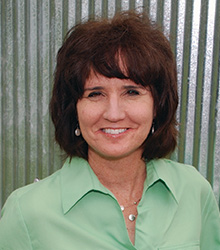Dealers came to this consensus at a roundtable discussion during Farm Equipment’s fourth annual Dealership Minds Summit, held recently in Iowa City, Iowa: Dealers are continuing to increase the amount they spend on digital marketing, but traditional methods still need to be part of the mix. And, digital marketing doesn’t bring success on its own, but requires a targeted approach, with the right keywords, “geo-fencing,” and a robust website that makes the visit worth it for your customers.
Amy Cope, marketing manager for Landmark Implement, led the discussion at the summit, which this year focused on the theme of Intelligence Driven Marketing. The John Deere dealership has 16 locations in Nebraska and Kansas.
“We’re fooling ourselves if we think the customers we have a good relationship with are calling us directly,” one attendee says. The dealers shared examples of long-time customers requesting information online even though they regularly work with a salesperson. Gone are the days when customers drive through the lot on weekends to see the new inventory.
However, one dealer shared this about the importance of a marketing mix, “I don’t think we can abandon anything right now.”
Setting a Budget
The group shared how they set their budget, with many basing it on a percentage of sales, ranging from .03% to about 3%. Several say they earmark the majority of the budget at the corporate level, with a percentage, for example 7% of the budget, divided among the various locations.
The corporate budget is marked for customer engagement and branding tactics and the stores handle tactics to reach the local community. Cope shared why that approach works for Landmark.
“The store manager has ownership over that budget and they’re the ones that get lots of calls about sponsorship. When our customers see us supporting their communities in little ways, like rodeos and fairs, they feel a sense of partnership,” she says.
One dealer says that a good share of their budget is dedicated to compact tractors because that equipment cuts across several markets and they found it necessary to maintain their market share. Others are exploring the idea of dedicated budget to equipment categories or to departments.
One attendee says, “We’re trying to do some marketing on the front end for parts and service, but struggling to find the formula.”
Many in the group shared opinions on manufacturer co-op advertising. It may seem like free money, but the restrictions on dealership branding vs. manufacturing branding keep dealers from using it.
Finding Success in Digital Strategies
The awareness and expertise about a key digital program, Google AdWords, varies among dealerships. For instance, one dealership in the group has a person on staff who used to work at Google. Another dealership sent an employee to a two-week training session and others are just getting started and turning to online tutorials.
One attendee says they allocate 20% of their budget to digital advertising, but expect to increase to 30% soon.
Several dealers shared these caveats regarding Google AdWords and digital advertising:
- Make sure your website has updated and relevant content. Google bases its pay-per-click rate for the keywords you chose on the robustness of your website, not to mention you want customers to turn a website visit into a purchase.
- Don’t turn to an advertising agency for your Google AdWords program. They often don’t know the market well enough to pick the right keywords. This can be a costly mistake, in addition to the agency fees.
Several dealers say they are spending significantly less on print advertising as part of their overall marketing budgets. One dealership says it is still a primary emphasis of theirs, though they have a small marketing budget to begin with.
Even though traditional forms of advertising, such as radio and print ads, are becoming less of an emphasis, they still have a place as part of an overall marketing mix, explains one dealer.
“I think putting all your eggs in one basket, these days, is completely remiss,” says the dealer. “I think it’s just about developing the right blend.”
Proving Value
The brainstorming group included salespeople, marketers and dealership principles and all were looking for sound ways to determine the return on investment of their marketing programs. A single-store dealer uses an Excel sheet to track leads through to purchase. Representatives from larger dealership groups say they use the Handle CRM software from CustomerTRAX as well as Oracle. One attendee says they have just started the process and are focusing now on tracking website leads, such as customers who request a quote or request a demo.
“Some of us use lead generation software and it becomes a marketing expense. We do need the discipline from the sales staff to help us close that loop. We can give them the information, ask where the lead came from, but if we don’t follow that through with our CRM, it’s not going to give us what we’re looking for. That’s a continual struggle, but I think that it will continue to get better the more that everyone uses it,” says Cope.
Meeting Other Marketing Challenges
The group discussed other challenges, including digital marketing for shortlines. Some attendees in the group carry more than 100 shortlines, so they don’t have the time to make sure their website has content similar to what they create for their majors. This limits the use of Google AdWords, for instance.
Another challenge are promotional items, a “necessary evil,” says one dealer. Several have struggled in the past with stores ordering items that didn’t have the proper logo or having large quantities that they had to store. One attendee says all promotional items are now ordered centrally and distributed to the stores. However, there is no set budget. Another dealer has set up an online store at Staples with about 30 promotional items that locations can order directly.
Finally, making sure management understands the value of marketing is an ongoing challenge. “There’s the perception is that marketing is just an expense. We end up gravitating to some level of ‘spend’ and say, ‘Well, we’ll just spend that same amount this year.’ If you ask for a conversation with management, they may say, ‘Oh my gosh, you’re spending that much.’”
This means quantifying return on investment has to be part of any marketing program and digital marketing tracking tools can help gather that data.
Learn More
-
How Dealers Can Use ROI to Sell More than Farm Equipment
To successfully sell customers on ROI, determine the numbers that are important to them — hours saved, fuel savings, yield increases — and go from there.







